Amy Loutfi
Örebro University, Örebro, Sweden
Relative Navigation and Dynamic Target Tracking for Autonomous Underwater Proximity Operations
Aug 23, 2025Abstract:Estimating a target's 6-DoF motion in underwater proximity operations is difficult because the chaser lacks target-side proprioception and the available relative observations are sparse, noisy, and often partial (e.g., Ultra-Short Baseline (USBL) positions). Without a motion prior, factor-graph maximum a posteriori estimation is underconstrained: consecutive target states are weakly linked and orientation can drift. We propose a generalized constant-twist motion prior defined on the tangent space of Lie groups that enforces temporally consistent trajectories across all degrees of freedom; in SE(3) it couples translation and rotation in the body frame. We present a ternary factor and derive its closed-form Jacobians based on standard Lie group operations, enabling drop-in use for trajectories on arbitrary Lie groups. We evaluate two deployment modes: (A) an SE(3)-only representation that regularizes orientation even when only position is measured, and (B) a mode with boundary factors that switches the target representation between SE(3) and 3D position while applying the same generalized constant-twist prior across representation changes. Validation on a real-world dynamic docking scenario dataset shows consistent ego-target trajectory estimation through USBL-only and optical relative measurement segments with an improved relative tracking accuracy compared to the noisy measurements to the target. Because the construction relies on standard Lie group primitives, it is portable across state manifolds and sensing modalities.
Interactive Double Deep Q-network: Integrating Human Interventions and Evaluative Predictions in Reinforcement Learning of Autonomous Driving
Apr 28, 2025Abstract:Integrating human expertise with machine learning is crucial for applications demanding high accuracy and safety, such as autonomous driving. This study introduces Interactive Double Deep Q-network (iDDQN), a Human-in-the-Loop (HITL) approach that enhances Reinforcement Learning (RL) by merging human insights directly into the RL training process, improving model performance. Our proposed iDDQN method modifies the Q-value update equation to integrate human and agent actions, establishing a collaborative approach for policy development. Additionally, we present an offline evaluative framework that simulates the agent's trajectory as if no human intervention had occurred, to assess the effectiveness of human interventions. Empirical results in simulated autonomous driving scenarios demonstrate that iDDQN outperforms established approaches, including Behavioral Cloning (BC), HG-DAgger, Deep Q-Learning from Demonstrations (DQfD), and vanilla DRL in leveraging human expertise for improving performance and adaptability.
Evaluation of Coordination Strategies for Underground Automated Vehicle Fleets in Mixed Traffic
Apr 27, 2025Abstract:This study investigates the efficiency and safety outcomes of implementing different adaptive coordination models for automated vehicle (AV) fleets, managed by a centralized coordinator that dynamically responds to human-controlled vehicle behavior. The simulated scenarios replicate an underground mining environment characterized by narrow tunnels with limited connectivity. To address the unique challenges of such settings, we propose a novel metric - Path Overlap Density (POD) - to predict efficiency and potentially the safety performance of AV fleets. The study also explores the impact of map features on AV fleets performance. The results demonstrate that both AV fleet coordination strategies and underground tunnel network characteristics significantly influence overall system performance. While map features are critical for optimizing efficiency, adaptive coordination strategies are essential for ensuring safe operations.
REvolve: Reward Evolution with Large Language Models for Autonomous Driving
Jun 03, 2024Abstract:Designing effective reward functions is crucial to training reinforcement learning (RL) algorithms. However, this design is non-trivial, even for domain experts, due to the subjective nature of certain tasks that are hard to quantify explicitly. In recent works, large language models (LLMs) have been used for reward generation from natural language task descriptions, leveraging their extensive instruction tuning and commonsense understanding of human behavior. In this work, we hypothesize that LLMs, guided by human feedback, can be used to formulate human-aligned reward functions. Specifically, we study this in the challenging setting of autonomous driving (AD), wherein notions of "good" driving are tacit and hard to quantify. To this end, we introduce REvolve, an evolutionary framework that uses LLMs for reward design in AD. REvolve creates and refines reward functions by utilizing human feedback to guide the evolution process, effectively translating implicit human knowledge into explicit reward functions for training (deep) RL agents. We demonstrate that agents trained on REvolve-designed rewards align closely with human driving standards, thereby outperforming other state-of-the-art baselines.
Cybersecurity and Embodiment Integrity for Modern Robots: A Conceptual Framework
Jan 15, 2024Abstract:Modern robots are stepping away from monolithic entities built using ad-hoc sensors and actuators, due to new technologies and communication paradigms, such as the Internet of Things (IoT) and the Robotic Operating System (ROS). Using such paradigms, robots can be built by acquiring heterogeneous standard devices and putting them in communication with each other. This approach brings high degrees of modularity, but it also yields uncertainty of providing cybersecurity assurances, and guarantees on the integrity of the embodiment. In this paper, we first illustrate how cyberattacks on different devices can have radically different consequences on the robot's ability to complete its tasks and preserve its embodiment. We also claim that modern robots should have self-awareness for what it concerns such aspects, and formulate the different characteristics that robots should integrate for doing so. Then, we show that achieving these propositions requires that robots possess at least three properties that conceptually link devices and tasks. Last, we reflect on how these three properties could be achieved in a larger conceptual framework.
Levels of Automation for a Mobile Robot Teleoperated by a Caregiver
Jul 21, 2021
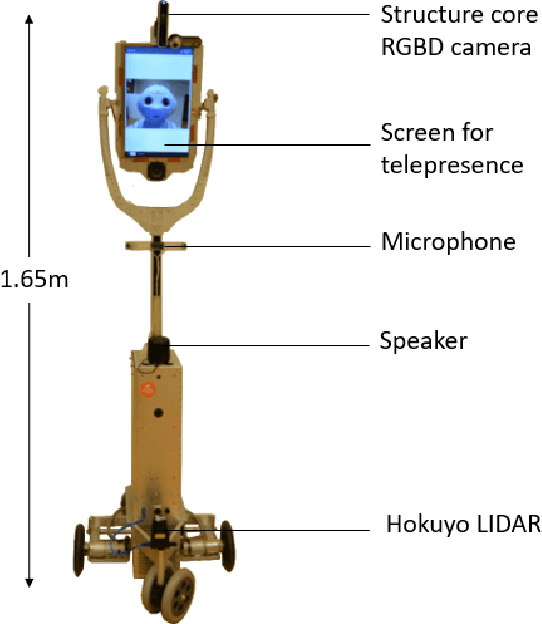
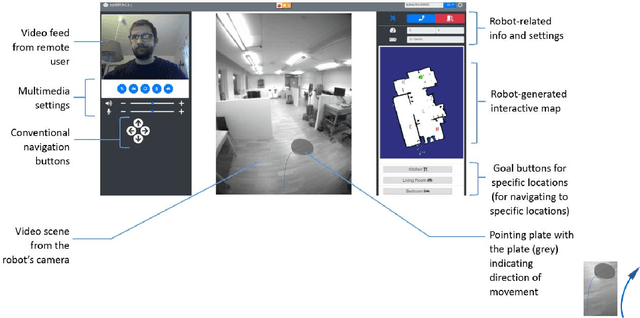
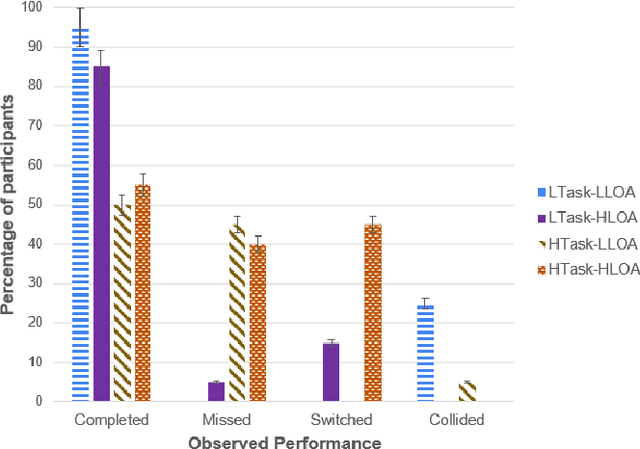
Abstract:Caregivers in eldercare can benefit from telepresence robots that allow them to perform a variety of tasks remotely. In order for such robots to be operated effectively and efficiently by non-technical users, it is important to examine if and how the robotic system's level of automation (LOA) impacts their performance. The objective of this work was to develop suitable LOA modes for a mobile robotic telepresence (MRP) system for eldercare and assess their influence on users' performance, workload, awareness of the environment and usability at two different levels of task complexity. For this purpose, two LOA modes were implemented on the MRP platform: assisted teleoperation (low LOA mode) and autonomous navigation (high LOA mode). The system was evaluated in a user study with 20 participants, who, in the role of the caregiver, navigated the robot through a home-like environment to perform various control and perception tasks. Results revealed that performance improved at high LOA when the task complexity was low. However, when task complexity increased, lower LOA improved performance. This opposite trend was also observed in the results for workload and situation awareness. We discuss the results in terms of the LOAs' impact on users' attitude towards automation and implications on usability.
An Open-Source Modular Robotic System for Telepresence and Remote Disinfection
Feb 02, 2021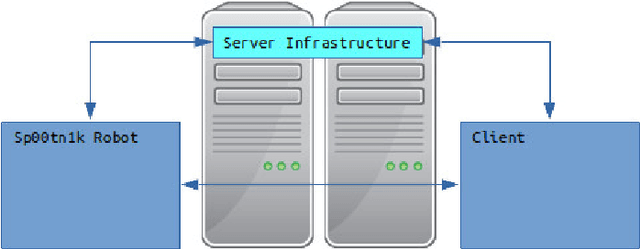
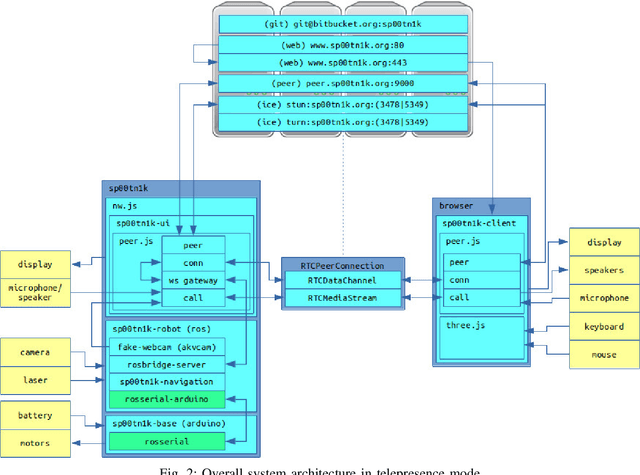
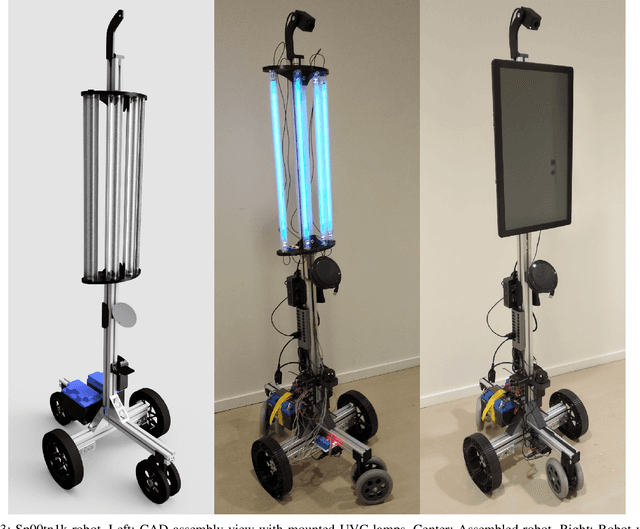
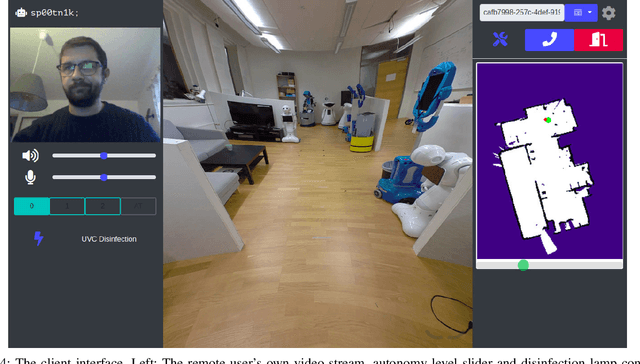
Abstract:In a pandemic contact between humans needs to be avoided wherever possible. Robots can take over an increasing number of tasks to protect people from being exposed to others. One such task is the disinfection of environments in which infection spread is particularly likely or bears increased risks. It has been shown that UVC light is effective in neutralizing a variety of pathogens, among others the virus causing COVID-19, SARS-CoV-2. Another function which can reduce the need for physical proximity between humans is interaction via telepresence, i.e., the remote embodiment of a person controlling the robot. This work presents a modular mobile robot for telepresence and disinfection with UVC lamps. Both operation modes are supported by adaptable autonomy navigation features for facilitating efficient task execution. The platform's primary contributions are its hardware and software design, which combine consumer-grade components and 3D-printed mounting with open-source software frameworks.
Reinforcement Learning Approaches in Social Robotics
Sep 21, 2020



Abstract:There is a growing body of literature that formulates social human-robot interactions as sequential decision-making tasks. In such cases, reinforcement learning arises naturally since the interaction is a key component in both reinforcement learning and social robotics. This article surveys reinforcement learning approaches in social robotics. We propose a taxonomy that categorizes reinforcement learning methods in social robotics according to the nature of the reward function. We discuss the benefits and challenges of such methods and outline possible future directions.
Online Guest Detection in a Smart Home using Pervasive Sensors and Probabilistic Reasoning
Mar 13, 2020
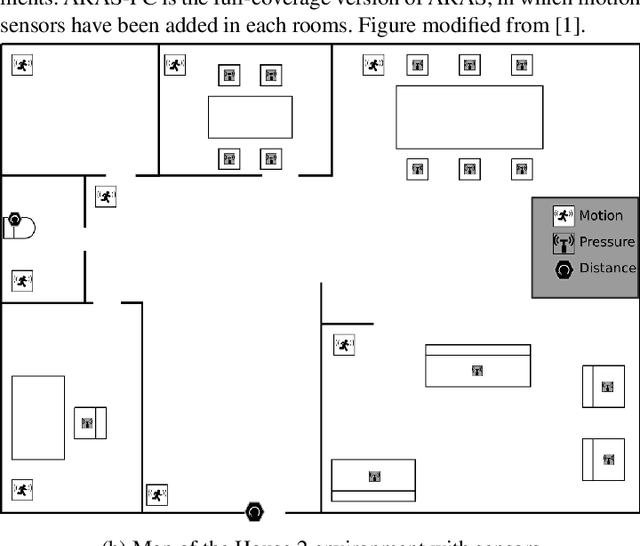
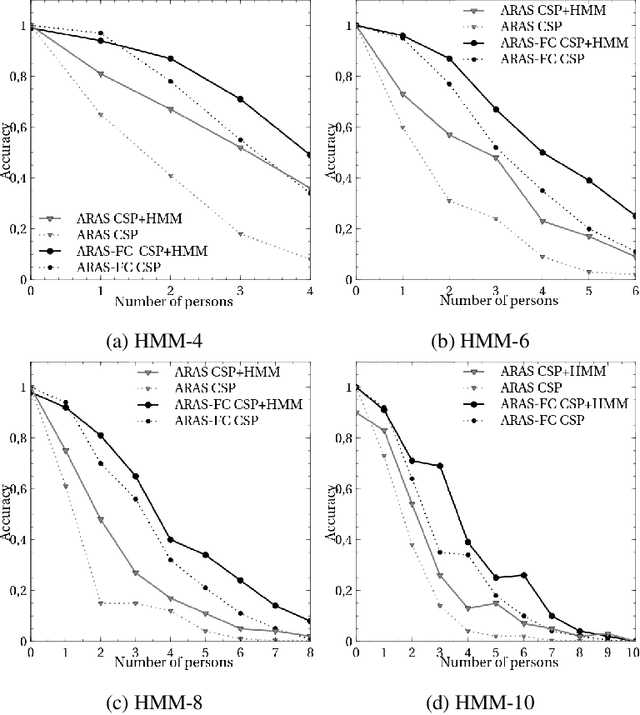
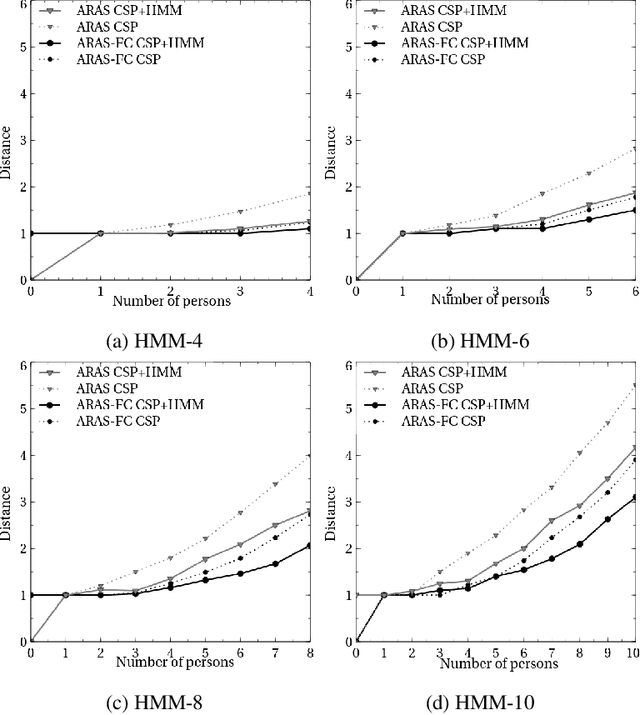
Abstract:Smart home environments equipped with distributed sensor networks are capable of helping people by providing services related to health, emergency detection or daily routine management. A backbone to these systems relies often on the system's ability to track and detect activities performed by the users in their home. Despite the continuous progress in the area of activity recognition in smart homes, many systems make a strong underlying assumption that the number of occupants in the home at any given moment of time is always known. Estimating the number of persons in a Smart Home at each time step remains a challenge nowadays. Indeed, unlike most (crowd) counting solution which are based on computer vision techniques, the sensors considered in a Smart Home are often very simple and do not offer individually a good overview of the situation. The data gathered needs therefore to be fused in order to infer useful information. This paper aims at addressing this challenge and presents a probabilistic approach able to estimate the number of persons in the environment at each time step. This approach works in two steps: first, an estimate of the number of persons present in the environment is done using a Constraint Satisfaction Problem solver, based on the topology of the sensor network and the sensor activation pattern at this time point. Then, a Hidden Markov Model refines this estimate by considering the uncertainty related to the sensors. Using both simulated and real data, our method has been tested and validated on two smart homes of different sizes and configuration and demonstrates the ability to accurately estimate the number of inhabitants.
Symbolic Learning and Reasoning with Noisy Data for Probabilistic Anchoring
Feb 24, 2020
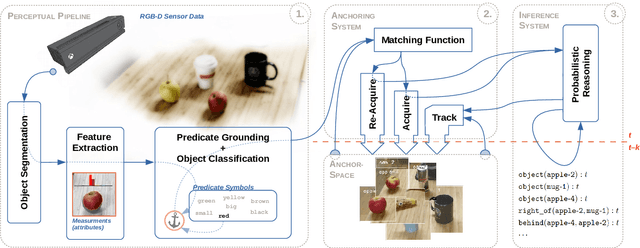
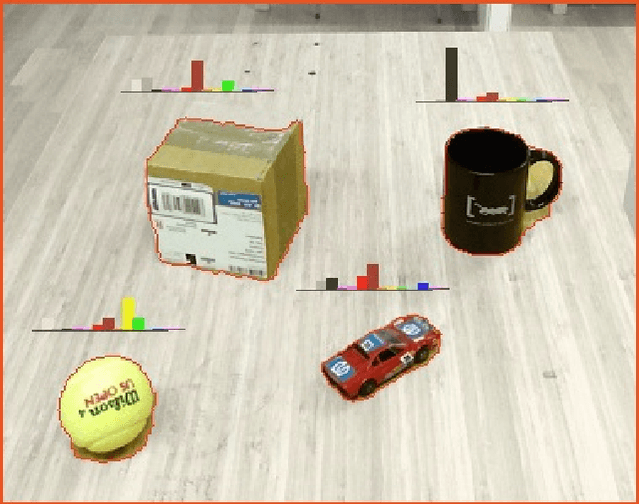
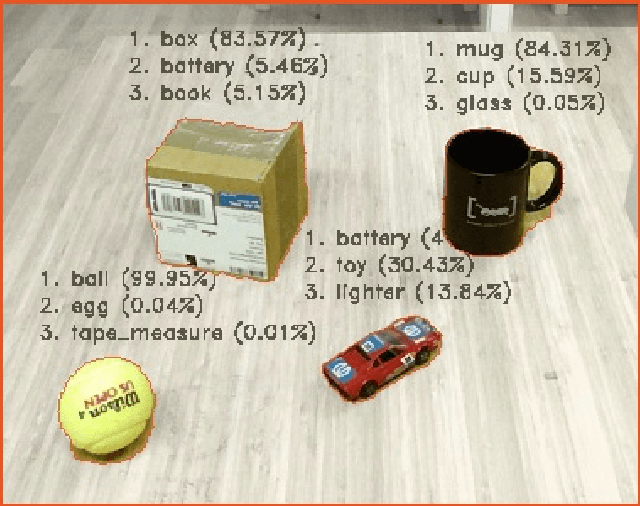
Abstract:Robotic agents should be able to learn from sub-symbolic sensor data, and at the same time, be able to reason about objects and communicate with humans on a symbolic level. This raises the question of how to overcome the gap between symbolic and sub-symbolic artificial intelligence. We propose a semantic world modeling approach based on bottom-up object anchoring using an object-centered representation of the world. Perceptual anchoring processes continuous perceptual sensor data and maintains a correspondence to a symbolic representation. We extend the definitions of anchoring to handle multi-modal probability distributions and we couple the resulting symbol anchoring system to a probabilistic logic reasoner for performing inference. Furthermore, we use statistical relational learning to enable the anchoring framework to learn symbolic knowledge in the form of a set of probabilistic logic rules of the world from noisy and sub-symbolic sensor input. The resulting framework, which combines perceptual anchoring and statistical relational learning, is able to maintain a semantic world model of all the objects that have been perceived over time, while still exploiting the expressiveness of logical rules to reason about the state of objects which are not directly observed through sensory input data. To validate our approach we demonstrate, on the one hand, the ability of our system to perform probabilistic reasoning over multi-modal probability distributions, and on the other hand, the learning of probabilistic logical rules from anchored objects produced by perceptual observations. The learned logical rules are, subsequently, used to assess our proposed probabilistic anchoring procedure. We demonstrate our system in a setting involving object interactions where object occlusions arise and where probabilistic inference is needed to correctly anchor objects.
 Add to Chrome
Add to Chrome Add to Firefox
Add to Firefox Add to Edge
Add to Edge